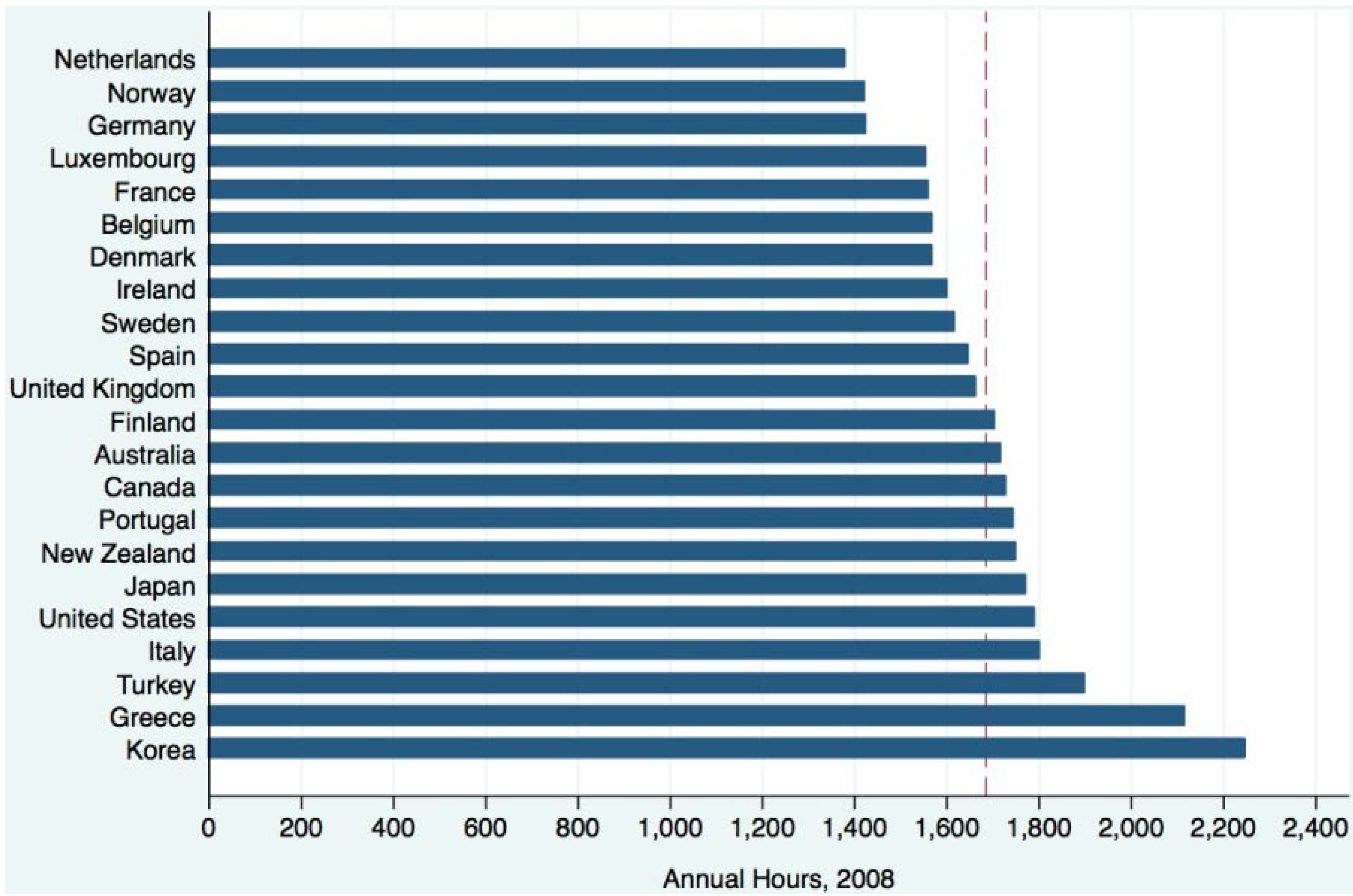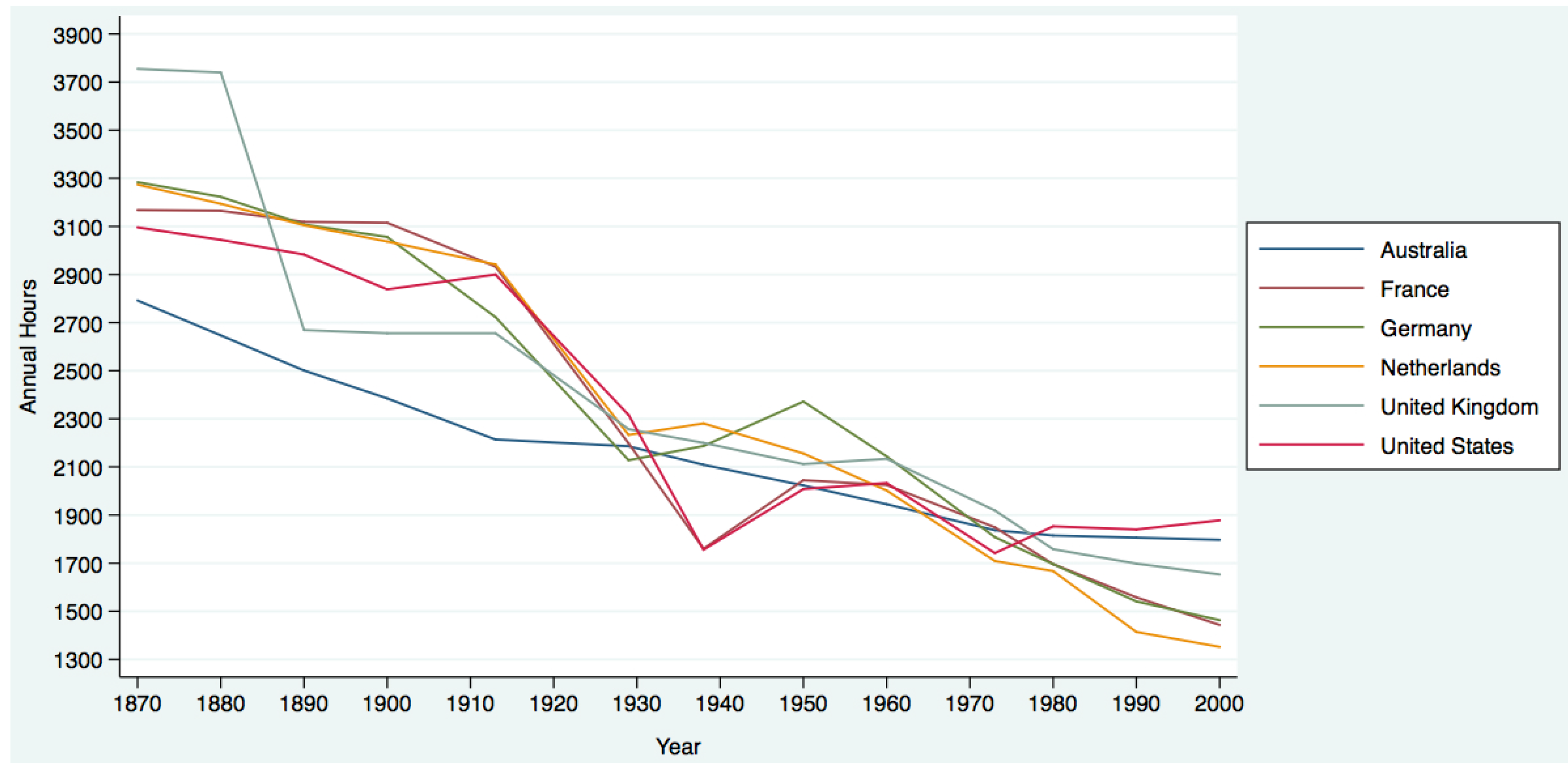“Friday off”: Reducing Working Hours in Europe
Abstract
:I would predict that the standard of life in progressive countries one hundred years hence will be between four and eight times as high as it is to-day... For many ages to come the old Adam will be so strong in us that everybody will need to do some work if he is to be contented… But beyond this, we shall endeavor to spread the bread thin on the butter-to make what work there is still to be done to be as widely shared as possible. Three-hour shifts or a fifteen-hour week may put off the problem for a great while. For three hours a day is quite enough to satisfy the old Adam in most of us!John Maynard Keynes
When the hours, the nature of the work done, the physical conditions under which it is done, and the method by which it is remunerated, are such as to cause great wear and tear of body or mind or both … then the labor has been extravagant from the point of view of society at large … In such a case a moderate diminution of the hours of labor would diminish the national dividend only temporarily: for as soon as the improved standard of life had had time to exert its full effect on the efficiency of the workers, their increased energy, intelligence and force of character would enable them to do as much as before in less time.Alfred Marshall
1. Introduction
2. The Evolution of Working Hours in Historical Perspective


3. Impacts on Productivity
3.1. Binary Economics: Distinguishing Productivity from Productiveness [25]
3.2. Working Hours and Effects on Labor and Capital Productiveness
4. Impacts on Employment
5. Leisure, Welfare, and Working hours
6. The Environmental Impacts of Reduced Working hours
7. Policy Design Considerations
8. Conclusions
Acknowledgements
Conflict of Interest
References and Notes
- Friedlingstein, P.; Houghton, R.A.; Marland, G.; Hackler, J.; Boden, T.A.; Conway, T.J.; Canadell, J.G.; Raupach, M.R.; Ciais, P.; Le Quéré, C. Update on CO2 emissions. Nat. Geosci. 2010, 3, 811–812. [Google Scholar] [CrossRef]
- Jackson, T. Prosperity without Growth: Economics for a Finite Planet; Routledge: London, UK, 2012. [Google Scholar]
- Victor, P.A. Growth, degrowth and climate change: A scenario analysis. Ecol. Econ. 2012, 84, 206–212. [Google Scholar] [CrossRef]
- Ashford, N.; Hall, R.P.; Ashford, R. The crisis in unemployment and consumer demand: Reconciliation with environmental sustainability. Environ. Innov. Soc. Trans. 2012, 2, 1–22. [Google Scholar]
- Victor, P. Questioning economic growth. Nature 2010, 468, 370–371. [Google Scholar] [CrossRef]
- Coote, A.; Franklin, J.; Simms, A. 21 Hours; NEF, The New Economics Foundation: London, UK, 2011. [Google Scholar]
- Ashford, R.; Hall, R.P.; Ashford, N.A. Broadening capital acquisition with the earnings of capital as a means of sustainable growth and environmental sustainability. Eur. Financ. Rev. 2012, October–November, 70–74. [Google Scholar]
- As used in this article, “capital” includes land, animals, structures, and machines – anything capable of being owned and employed in production. It does not include “financial capital,” which is a claim on, or ownership interest in, real capital.
- Kelly, M. Owning Our Future: The Emerging Ownership Revolution; Barrett-Koehler: San Francisco, CA, USA, 2012. [Google Scholar]
- Rosen, C.; Case, J.; Staubus, M. Equity: Why Employee Ownership Is Good for America; Harvard Business Review Press: Cambridge, MA, USA, 2005. [Google Scholar]
- The approach that came to be known as binary economics was first advanced in the writings of Louis Kelso in a number of books and articles. The most authoritative collection of his works can be found at www.kelsoinstitute.org.
- Lee, S.; McCann, D.; Messenger, J. Working Time around the World; International Labor Organisation, Routledge: London, UK, 2007. [Google Scholar]
- Voth, H.-J. Time and Work in England 1750-1830; Clarendon Press: Oxford, UK, 2000. [Google Scholar]
- Voth, H.-J. Living standards during the industrial revolution: An economist’s guide. Am. Econ. Rev. 2003, 93, 221–226. [Google Scholar] [CrossRef]
- Taylor, J.E. Work-sharing during the Great Depression: Did the “President’s Reemployment Agreement” promote reemployment? Economica 2011, 78, 133–158. [Google Scholar] [CrossRef]
- Alesina, A.; Glaeser, E.; Sacerdote, B. Work and leisure in the US and Europe: Why so different? NBER Macroeconomic Annual, NBER Working Paper No. 11278; National Bureau of Economic Research: Washington, DC, USA, 2005; Volume 20. [Google Scholar]
- Hunt, J. Has work-sharing worked in germany? Q. J. Econ. 1999, 114, 117–148. [Google Scholar] [CrossRef]
- Huberman, M.; Minns, C. The times they are not changin’: Days and hours of work in Old and New Worlds, 1870–2000. Explor. Econ. Hist. 2007, 44, 538–567. [Google Scholar] [CrossRef]
- Schor, J.B. Sustainable consumption and worktime reduction. J. Ind. Ecol. 2005, 9, 37–50. [Google Scholar] [CrossRef]
- Prescott, E. Why do Americans work so much more than Europeans? Fed. Reserve Bank Minneap. Q. Rev. 2004, 28, 2–13. [Google Scholar]
- Blanchard, O. The economic future of Europe. J. Econ. Perspect. 2004, 18, 3–26. [Google Scholar] [CrossRef]
- Maddison, A. The World Economy: A Millennial Perspective; OECD: París, France, 2001. [Google Scholar]
- ILO, Key Indicators of the Labor Market (KILM), 3rd edILO: Geneva, Switzerland, 2003.
- European Commission, Self-Employment in Europe; European Employment Observatory Review: Brussels, Belgium, 2010.
- This sub-section draws heavily from Ashford, N.; Hall, R.P.; Ashford, R. The crisis in unemployment and consumer demand: Reconciliation with environmental sustainability. Environ. Innov. Soc. Trans. 2012, 2, 1–22.
- Bosch, G.; Lehndorff, S. Working-time reduction and employment experiences in Europe and economic policy recommendations. Camb. J. Econ. 2001, 25, 209–243. [Google Scholar] [CrossRef]
- Fitzgerald, T.J. Reducing Working Hours. Economic Review 1996, 13–22. [Google Scholar]
- Van Ark, B.; O’Mahony, M.; Timmer, M. The productivity gap between Europe and the United States: Trends and causes. J. Econ. Perspect. 2008, 22, 25–44. [Google Scholar] [CrossRef]
- Black, S.; Lynch, L. How to compete: The impact of workplace practices and information technology on productivity. Rev. Econ. Stat. 2001, 83, 434–445. [Google Scholar]
- Crépon, B.; Kramarz, B. Employed 40 Hours or Not-Employed 39: Lessons from the 1982 Mandatory Reduction of the Workweek. J. Polit. Econ. 2002, 110, 1355–1389. [Google Scholar] [CrossRef]
- Schor, J.B. Plenitude: The New Economics of True Wealth; Penguin: New York, NY, USA, 2010. [Google Scholar]
- Rezai, A.; Taylor, L.; Mechler, R. Ecological macroeconomics: An application to climate change. Ecol. Econ. 2013, 85, 69–76. [Google Scholar] [CrossRef] [Green Version]
- Ayres, R.; Warr, B. The Economic Growth Engine: How Energy and Work Drive Material Prosperity; Edward Elgar Publishing: Williston, VT, USA, 2009. [Google Scholar]
- Coleman, M.; Pencavel, J. Changes in Work Hours of Male Employees, 1940–1988. Ind. Labor Relat. Rev. 1993, 46, 262–283. [Google Scholar] [CrossRef]
- Landsbergis, P. The changing organization of work and the health and safety of working people: A commentary. J. Occup. Environ. Med. 2003, 45, 61–72. [Google Scholar] [CrossRef]
- Booth, A.; Ravallion, M. Employment and length of the working week in a unionised economy in which hours of work influence productivity. Econ. Record 1993, 69, 428–436. [Google Scholar] [CrossRef]
- Hart, R. Working Time and Employment; Allen & Unwin: Boston, MA, USA, 1987. [Google Scholar]
- Caruso, C.; Bushnell, T.; Eggerth, D.; Heitmann, A.; Kojola, B.; Newman, K.; Rosa, R.; Sauter, S.; Vila, B. Long working hours, safety and health. Am. J. Ind. Med. 2006, 49, 930–942. [Google Scholar] [CrossRef]
- Johnson, J.; Lipscomb, J. Long working hours, occupational health and the changing nature of work organization. Am. J. Ind. Med. 2006, 49, 921–929. [Google Scholar] [CrossRef]
- Hunt, J.; Katz, L. Hours Reductions and Work-Sharing. Brookings Papers on Economic Activity. 1998; pp. 339–381. [Google Scholar]
- Peltola, P. Working time reduction in Finland. Transf. Eur. Rev. Labor Res. 1998, 4, 729–746. [Google Scholar] [CrossRef]
- Nelen, A.; de Grip, A.; Fouarge, D. Is Part-Time Employment Beneficial for Firm Productivity? IZA; Discussion Paper No. 5423; 2011. [Google Scholar]
- Weil, D.W. Economic Growth; Addison-Wesley: New York, NY, USA, 2009. [Google Scholar]
- Krugman, P. Making sense of the competitiveness debate. Oxf. Rev. Econ. Policy 1996, 12, 17–25. [Google Scholar]
- Walker, T. Why economists dislike a lump of labor. Rev. Soc. Econ. Taylor Francis J. 2007, 65, 279–291. [Google Scholar] [CrossRef]
- Krugman, P. End this Depression Now; W.W. Norton and Company: London, UK and New York, NY, USA, 2012. [Google Scholar]
- Estevão, M.; Sá, F. The 35-hour workweek in France: Straightjacket or welfare improvement? Econ. Policy 2008, 23, 417–463. [Google Scholar] [CrossRef]
- Stiglitz, J.; Sen, A.; Fitoussi, J. Mismeasuring Our Lives. In Why GDP doesn’t Add up; The Report by the Commission on the Measurement of Economic Performance and Social Progress; The New Press: New York, NY, USA, 2010. [Google Scholar]
- Luttmer, E. Neighbors as negatives: Relative earnings and well-being. Q. J. Econ. 2005, 120, 963–1002. [Google Scholar]
- Pouwels, B.; Siegers, J.; Vlasblom, J.D. Income, working hours, and happiness. Econ. Lett. 2008, 99, 72–74. [Google Scholar]
- Otterbach, S. Mismatches between actual and preferred work time: Empirical evidence of hours constraints in 21 countries. J. Consum. Policy 2010, 33, 143–161. [Google Scholar] [CrossRef]
- Reynolds, J. Pursuing preferences: The creation and resolution of work hour mismatches. Am. Sociol. Rev. 2006, 71, 618–638. [Google Scholar]
- Devetter, F.; Rousseau, S. Working hours and sustainable development. Rev. Soc. Econ. 2011, 69, 333–355. [Google Scholar] [CrossRef]
- Jalas, M. A time use perspective on the materials intensity of consumption. Ecol. Econ. 2002, 41, 109–123. [Google Scholar] [CrossRef]
- Van den Bergh, J. Environment versus growth—A criticism of “degrowth” and a plea for a-growth. Ecol. Econ. 2011, 70, 881–890. [Google Scholar] [CrossRef]
- Gorz, A. Farewell to the Working Class. An essay on Post-Industrialism; Pluto Press: London, UK, 1982. [Google Scholar]
- Hayden, A.; Shandra, J. Hours of work and the ecological footprint: An exploratory analysis. Local Environ. 2009, 14, 574–600. [Google Scholar]
- Rosnick, D.; Weisbrot, M. Are shorter hours good for the environment? A comparison of US and European energy consumption. Int. J. Health Serv. 2007, 37, 405–417. [Google Scholar]
- Knight, K.; Rosa, E.A.; Schor, J.B. Reducing Growth to Achieve Environmental Sustainability: The Role of Work Hours; Political Economy Research Institute Working Paper Series, Number 304; University of Massachusetts: Amherst, MA, USA, 2012. [Google Scholar]
- Sorman, A.H.; Giampietro, M. The energetic metabolism of societies and the degrowth paradigm: Analyzing biophysical constraints and realities. J. Clean. Prod. 2011, 38, 80–93. [Google Scholar]
- Taylor, L. Energy Productivity, Labor Productivity and Global Warming. In Twenty-‐First Century Macroeconomics: Responding to the Climate Challenge; Harris, J.M., Goodwin, N.R., Eds.; Edward Elgar: Northhampton, MA, USA, 2009. [Google Scholar]
- Kallis, G. Societal metabolism, working hours and degrowth A comment on Sorman and Giampietro. J. Clean. Prod. 2012, 38, 94–98. [Google Scholar] [CrossRef]
- Costa, D. The unequal work day: A long-term view. Am. Econ. Rev. 1998, 88, 330–334. [Google Scholar]
© 2013 by the authors; licensee MDPI, Basel, Switzerland. This article is an open access article distributed under the terms and conditions of the Creative Commons Attribution license (http://creativecommons.org/licenses/by/3.0/).
Share and Cite
Kallis, G.; Kalush, M.; O.'Flynn, H.; Rossiter, J.; Ashford, N. “Friday off”: Reducing Working Hours in Europe. Sustainability 2013, 5, 1545-1567. https://doi.org/10.3390/su5041545
Kallis G, Kalush M, O.'Flynn H, Rossiter J, Ashford N. “Friday off”: Reducing Working Hours in Europe. Sustainability. 2013; 5(4):1545-1567. https://doi.org/10.3390/su5041545
Chicago/Turabian StyleKallis, Giorgos, Michael Kalush, Hugh O.'Flynn, Jack Rossiter, and Nicholas Ashford. 2013. "“Friday off”: Reducing Working Hours in Europe" Sustainability 5, no. 4: 1545-1567. https://doi.org/10.3390/su5041545



